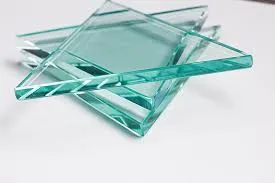Standard Float Glass An Overview
Standard float glass, often simply referred to as float glass, is a fundamental material widely utilized in construction, automotive, and decorative applications due to its clarity, durability, and versatility. The manufacturing process of float glass was pioneered in the mid-20th century by Sir Alastair Pilkington, and it revolutionized the way glass was produced and utilized across various industries.
The float glass manufacturing process involves melting raw materials such as silica sand, soda ash, and limestone at high temperatures to form molten glass. This molten glass is then floated on top of molten tin in a large bath. The floating process is critical because it allows the glass to spread evenly, resulting in a smooth and flat surface. As the glass cools, it takes on a uniform thickness, typically ranging from 2mm to 19mm, and achieves a high level of optical clarity.
One of the primary advantages of standard float glass is its visual quality
. It offers excellent transparency and minimal distortion, making it an ideal choice for windows, doors, and facades in buildings. Moreover, float glass can be manufactured in large sheets, enabling architects and designers to create expansive glass surfaces that enhance the aesthetic appeal of structures while allowing natural light to permeate interiors.
standard float glass
In addition to its aesthetic qualities, standard float glass demonstrates impressive durability. It is resistant to weathering, making it suitable for various environmental conditions. However, it is essential to note that although float glass can withstand significant impact, it is not shatterproof. Hence, safety features such as tempered or laminated glass are often recommended for areas that require enhanced security and safety.
Float glass can also be further processed to achieve specific functionalities. For instance, it can be coated with reflective or low-emissivity (Low-E) coatings to improve energy efficiency in buildings. These coatings can reduce heat transfer, contributing to lower energy costs in heating and cooling. Furthermore, float glass can be tinted or colored to meet aesthetic desires or to control glare and light transmission.
In recent years, the demand for sustainable building materials has risen significantly. Standard float glass is recyclable, and many manufacturers are increasingly incorporating recycled glass in their production processes. This approach not only reduces waste but also minimizes the environmental impact associated with glass manufacturing.
Overall, standard float glass serves as a crucial component in modern architecture and design, offering unmatched clarity, versatility, and strength while adapting to the evolving needs of society. Its continued innovation and application underscore its significance in various industries, making it a timeless material in both functional and decorative contexts.
 Afrikaans
Afrikaans  Albanian
Albanian  Amharic
Amharic  Arabic
Arabic  Armenian
Armenian  Azerbaijani
Azerbaijani  Basque
Basque  Belarusian
Belarusian  Bengali
Bengali  Bosnian
Bosnian  Bulgarian
Bulgarian  Catalan
Catalan  Cebuano
Cebuano  Corsican
Corsican  Croatian
Croatian  Czech
Czech  Danish
Danish  Dutch
Dutch  English
English  Esperanto
Esperanto  Estonian
Estonian  Finnish
Finnish  French
French  Frisian
Frisian  Galician
Galician  Georgian
Georgian  German
German  Greek
Greek  Gujarati
Gujarati  Haitian Creole
Haitian Creole  hausa
hausa  hawaiian
hawaiian  Hebrew
Hebrew  Hindi
Hindi  Miao
Miao  Hungarian
Hungarian  Icelandic
Icelandic  igbo
igbo  Indonesian
Indonesian  irish
irish  Italian
Italian  Japanese
Japanese  Javanese
Javanese  Kannada
Kannada  kazakh
kazakh  Khmer
Khmer  Rwandese
Rwandese  Korean
Korean  Kurdish
Kurdish  Kyrgyz
Kyrgyz  Lao
Lao  Latin
Latin  Latvian
Latvian  Lithuanian
Lithuanian  Luxembourgish
Luxembourgish  Macedonian
Macedonian  Malgashi
Malgashi  Malay
Malay  Malayalam
Malayalam  Maltese
Maltese  Maori
Maori  Marathi
Marathi  Mongolian
Mongolian  Myanmar
Myanmar  Nepali
Nepali  Norwegian
Norwegian  Norwegian
Norwegian  Occitan
Occitan  Pashto
Pashto  Persian
Persian  Polish
Polish  Portuguese
Portuguese  Punjabi
Punjabi  Romanian
Romanian  Russian
Russian  Samoan
Samoan  Scottish Gaelic
Scottish Gaelic  Serbian
Serbian  Sesotho
Sesotho  Shona
Shona  Sindhi
Sindhi  Sinhala
Sinhala  Slovak
Slovak  Slovenian
Slovenian  Somali
Somali  Spanish
Spanish  Sundanese
Sundanese  Swahili
Swahili  Swedish
Swedish  Tagalog
Tagalog  Tajik
Tajik  Tamil
Tamil  Tatar
Tatar  Telugu
Telugu  Thai
Thai  Turkish
Turkish  Turkmen
Turkmen  Ukrainian
Ukrainian  Urdu
Urdu  Uighur
Uighur  Uzbek
Uzbek  Vietnamese
Vietnamese  Welsh
Welsh  Bantu
Bantu  Yiddish
Yiddish  Yoruba
Yoruba  Zulu
Zulu 

